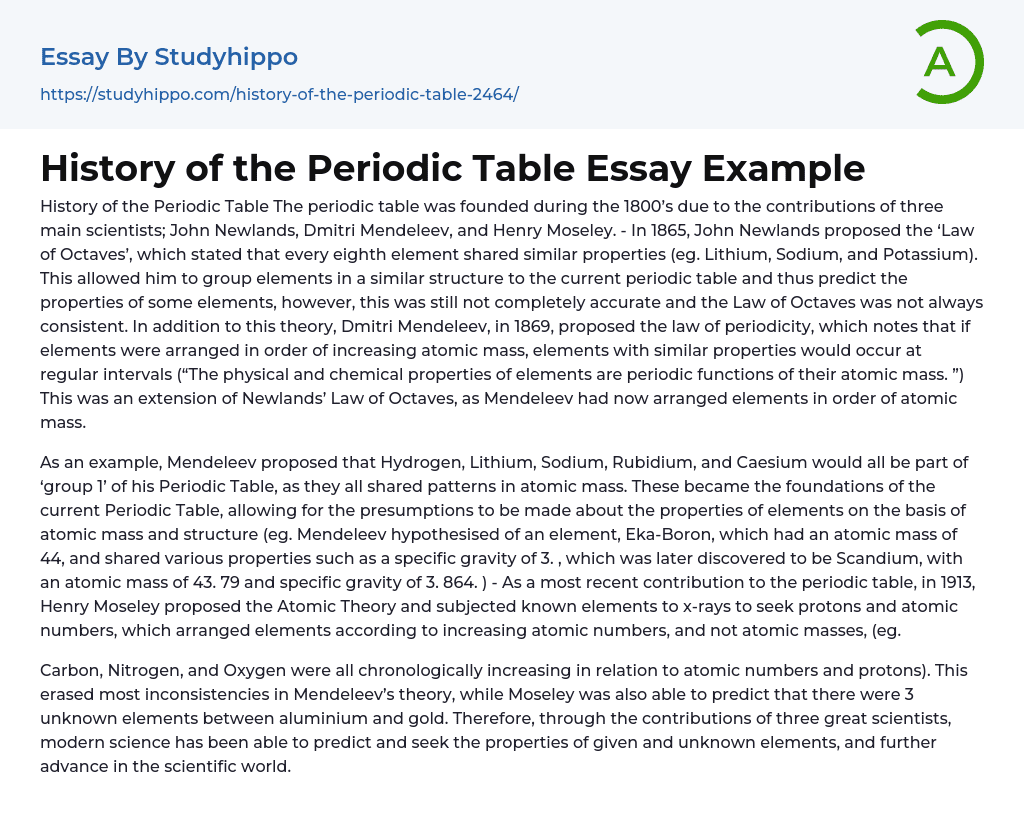History of the Periodic Table The periodic table was founded during the 1800’s due to the contributions of three main scientists; John Newlands, Dmitri Mendeleev, and Henry Moseley. - In 1865, John Newlands proposed the ‘Law of Octaves’, which stated that every eighth element shared similar properties (eg. Lithium, Sodium, and Potassium). This allowed him to group elements in a similar structure to the current periodic table and thus predict the properties of some elements, however, this was still not completely accurate and the Law of Octaves was not always consistent. In addition to this theory, Dmitri Mendeleev, in 1869, proposed the law of periodicity, which notes that if elements were arranged in order of increasing atomic mass, elements with similar properties would occur at regular intervals (“The physical and chemical pro
...perties of elements are periodic functions of their atomic mass. ”) This was an extension of Newlands’ Law of Octaves, as Mendeleev had now arranged elements in order of atomic mass.
As an example, Mendeleev proposed that Hydrogen, Lithium, Sodium, Rubidium, and Caesium would all be part of ‘group 1’ of his Periodic Table, as they all shared patterns in atomic mass. These became the foundations of the current Periodic Table, allowing for the presumptions to be made about the properties of elements on the basis of atomic mass and structure (eg. Mendeleev hypothesised of an element, Eka-Boron, which had an atomic mass of 44, and shared various properties such as a specific gravity of 3. , which was later discovered to be Scandium, with an atomic mass of 43. 79 and specific gravity of 3. 864. ) - As a most recent contribution t
the periodic table, in 1913, Henry Moseley proposed the Atomic Theory and subjected known elements to x-rays to seek protons and atomic numbers, which arranged elements according to increasing atomic numbers, and not atomic masses, (eg.
Carbon, Nitrogen, and Oxygen were all chronologically increasing in relation to atomic numbers and protons). This erased most inconsistencies in Mendeleev’s theory, while Moseley was also able to predict that there were 3 unknown elements between aluminium and gold. Therefore, through the contributions of three great scientists, modern science has been able to predict and seek the properties of given and unknown elements, and further advance in the scientific world.
- Russian Empire essays
- Ancient Greece essays
- British Empire essays
- Historical Figures essays
- Nazi Germany essays
- Roman Empire essays
- War essays
- Revolution essays
- 19Th Century essays
- Historiography essays
- History of the United States essays
- 20Th Century essays
- World History essays
- Vikings essays
- Declaration of Independence essays
- Civilization essays
- Evidence essays
- Genocide essays
- Colonialism essays
- Rebellion essays
- 1960S essays
- 1920S essays
- 1950S essays
- Letter from Birmingham Jail essays
- Louisiana Purchase essays
- The Columbian Exchange essays
- World Hunger essays
- What is History essays
- Bravery essays
- Gilded Age essays
- Vladimir Lenin essays
- Alexander The Great essays
- Sparta essays
- Victorian Era essays
- Henry v essays
- Stonehenge essays
- Frederick Douglass essays
- Mahatma Gandhi essays
- Joseph Stalin essays
- Geert Hofstede essays
- George Eliot essays
- Ginevra King essays
- John Keats essays
- Siegfried Sassoon essays
- Ben jonson essays
- Billy elliot essays
- Wilkie collins essays
- John Proctor essays
- Harriet Tubman essays
- Napoleon essays




